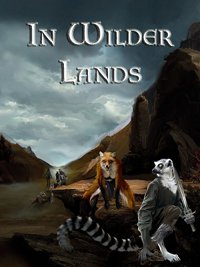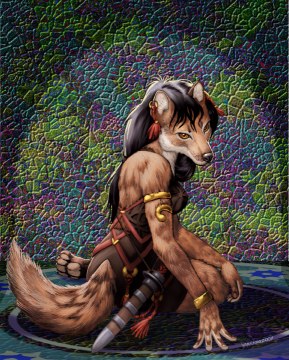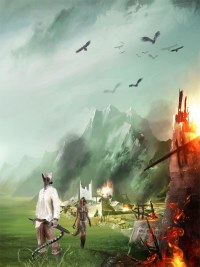Review: 'In Wilder Lands: The Fall of Eldvar', by Jim Galford
 Eldvar seems like a stereotypical fantasy world, inhabited by humans, pointy-eared elves, dwarves, and orcs alike; some of whom are skilled magic-users. But they all persecute the animal peoples, the wildlings, like Estin.
Eldvar seems like a stereotypical fantasy world, inhabited by humans, pointy-eared elves, dwarves, and orcs alike; some of whom are skilled magic-users. But they all persecute the animal peoples, the wildlings, like Estin.
While the town [the city-state of Altis] may have been run by an amalgam of races, his kind were not welcome. (p. 2)
North Charleston, SC, CreateSpace, August 2011, trade paperback $13.99 (452 pages), Kindle $2.99.
What does Estin look like? (Yes, his picture is on Danijel Firak’s cover, but if you can make it out on Amazon.com’s reduction, you have better eyes than I do. [Ed: Here's a closer look from the Kindle preview - back cover])
He dragged his claws across the stones. […] Thick pads covered the inner-side of his hands and his feet, giving him an incredible grip and the ability to climb out of harm’s way with ease. […] … he had long since learned that his hands and feet would scale buildings as easily as any tree. […] Estin noted dryly that his own ears were no less pointed [than the elves] […] He looked down and saw that one of the guards must have leapt and was hanging precariously from Estin’s eight-foot long black-and-white striped tail. […] He had a strong tail, capable of lifting himself off the ground, but it was not built for picking up armored humans. […] ‘That’s a good…,’ the man stopped and looked at the others, ‘what the hell is it, anyway?’ […] By the time he was stuffing the last bite of the third [orange] into his long mouth and realized just how much juice was matted into his fur, […] (pgs. 2-6)
The “what the hell is it, anyway?” clues the reader that Estin is unusual even for a wildling. He is the only one of his kind that he knows of … a prey animal, not a predator.
He has a good vocabulary, even if the humans won’t believe it:
Turning the broom over, the man swept the fruit into their hovel of a home, without taking his eyes off Estin. Once the last of the oranges was behind him, he flipped the broom over again and jabbed Estin in the chest with the bristles.
‘Ow,’ Estin exclaimed, a bit surprised. ‘I’m just trying to help.’
‘Get!’ the man snapped, swatting Estin on the bridge of the nose with the broom. ‘Get outta here! Shoo!’
‘I can talk, you know,’ mumbled Estin, backing into the dark hallway. ‘Maybe I can help…’ (p. 7)
The only other wildlings that Estin ever sees are slaves – and Nyess, the de facto boss of Altis’ underworld:
Nyess was a wildling – an animal person – just like Estin, though he bore little similarity. Slightly smaller in stature, Nyess looked just like a large rat, whereas Estin had somewhat more of a human body shape. The only non-animal thing about Nyess was his thin shirt and pants, as well as the tiny top hat he always wore to make himself appear more professional. The man really only cared about being able to manipulate other beings into projects that furthered his hoarding of coin. (p. 12)
 Estin has grown up while hiding in the slums of Altis, a loner working for Altis’ criminal underworld run by Nyess. Estin is especially unfamiliar with the wildling tribes of the mountains north of Altis, since his tribe lived in the south. It all comes to a head for Estin when he senses that he has just become expendable to Nyess, and that Altis is no longer safe for him.
Estin has grown up while hiding in the slums of Altis, a loner working for Altis’ criminal underworld run by Nyess. Estin is especially unfamiliar with the wildling tribes of the mountains north of Altis, since his tribe lived in the south. It all comes to a head for Estin when he senses that he has just become expendable to Nyess, and that Altis is no longer safe for him.
A final assignment takes him to the throne room of Altis’ duke, where he sees a wildling emissary, the fox-woman Feanne, betrayed and imprisoned. Betrayed himself, Estin rescues Feanne so they can help each other escape Altis.
Their joint escape helps to emphasize Estin’s wildling nature:
As they progressed, Estin sniffed the air, trying to learn what was around them, if only to distract him from the nausea he was suffering. He recognized the pines, but a thousand other scents confused him and blurred together. Some were likely flowers, some animal, some he simply had no idea. Having not left the city in so many years, everything out here was alien to him, drowning his mind in new scents that he had no way to sort out.
Struggling to make sense of all the things his nose picked up, Estin tried to center his thoughts and managed to pick out strong familiar aromas in an effort to piece things out one at a time. The rich smell of Feanne’s heavily-oiled leather vest and loincloth was easy to latch onto as a singular point in the sea of scents. Once he smelled that, he separated her unique scent from that of the leather, making a note of it so that he could recognize her more easily. It was a heavy woody smell of fur, mixed with the oils of the leather that had stained her fur, along with the more bitter additions of blood and one other item that he could not quite pick out. He was sure it was animal, but it was distinct from the leather and from Feanne herself. It smelled vaguely fox-like, but could have been just another wilding, or even a different breed of fox. (p. 78)
That takes In Wilder Lands up to about page 80. The rest of the novel tells of Estin’s life as a member of Feanne’s wilder forest community:
Estin hurried outside, stumbling as he emerged into blazing sunlight. He stood there a moment, letting his eyes adjust, but when they did, he barely believed what they showed him.
Wildlings were everywhere. Ulra and another bear were off to one side of the forest clearing, dragging dead wood the size of small trees in from the tree line, likely for firewood. Several wolves – including Ghohar – were scattered near the wood line, patrolling the camp’s edges for intruders. He spotted several other breeds running around, but they were there and gone so quickly, that he had a hard time identifying them.
‘You, you, you!’ exclaimed an excitable ferret, racing up on him. The young male darted in circles around Estin, prodding him with a clawed finger as though checking on his previous wounds. Like many of the others around the camp, the ferret was dressed in little more than a loincloth. ‘Asrahn got you all fixed up, that’s great! Where are you going now? Hrm? Say something!’ (p. 90)
Asrahn, a cat healer/magician, is determined that Estin, to prove his worth to the wildling pack, should also become a healer. At the same time, Altis’ attacks against the wildlings become more frequent and deadly. Before, Altis raided the wildlings occasionally to get slaves. Now, the humans and their elf/dwarf/orc allies seem determined to kill all wildlings by necromancy, as part of Altis’ escalating its generations-old war against the Kingdom of Lantonne. (It is this war that will result in “the fall of Eldvar”.)
Estin’s ever-evolving role in the wildling community – later, among the humans as the war grows out of all sides’ control -- and his confused relationship with Feanne (their different breeds definitely complicate matters) makes In Wilder Lands a richly convoluted, excessively long (spanning many years), surprise-filled, but very readable novel. There are many little snippets of description that will be of interest to readers:

It took about ten minutes to pass the last tent, given how erratically spaced they were. This was partially due to the varying size of the wildlings here, but also their breeds played a large part in it. When he had first arrived, Feanne had explained that the southern section – where Estin stayed – was mostly filled with animal-types that were at least primarily herbivores, though a great many were omnivores. Those who ate flesh as their main sustenance were here on the north end, helping to cut down on instinctual fights that Lihuan [the wildlings’ leader] had no desire to deal with directly. (pgs. 127-128)
Unlike most of the more predatory wildlings who wore deerskin leather, she [a deer-girl] wore a simple shirt and loose pants of thin fabric – which somehow made Estin utter an internal sigh of relief at not having to justify her wearing her namesake breed’s skin for clothing. (p. 139)
Jim Galford has a website, and he has given several interviews. These contain much background information. Galford is a Colorado-based computer system administrator, and his world of Eldvar was created for the CoreLARP game system. In April 2011 Galford underwent spinal surgery, and during a long bedridden convalescence he put some of the Eldvar background into this novel. Since most of the novel is set in the mountains above Altis, Galford based most of its wildlings on the mountain animals around Colorado, except for the outsider Estin. Estin is based on a ring-tailed lemur. Feanne is based on a fox, Ulra on a bear, Alafa on a deer/elk, and so on.
Galford’s first draft of In Wilder Lands was over 200,000 words, which he was persuaded to edit down to about 150,000 words/452 pages. He has lots of material for a sequel and for other novels set in Eldvar, not all of which will feature the wildlings. If they are all as good as In Wilder Lands, readers will look forward to them even without wildlings.
Read more: An interview with Jim Galford and Feanne - first chapter-and-a-half preview
About the author
Fred Patten — read stories — contact (login required)a retired former librarian from North Hollywood, California, interested in general anthropomorphics
Comments
tl;wrl
Too long; will read later.
On a whim I picked up the ebook version and turned out being pretty decent.
The writing is clean and very few unnecessary details for given scenes are included. The characters are unique, likeable, and show a good deal of growth. The plot is never pulled out of nowhere and never left me wondering what the hell is going.
I do have some problems with the book, however. The biggest issue is that the book feels like it is written within a role playing game, and as it turns out, it is. Due to this there is very little fantastic in the book's world. Magic is very prevalent and life and death seem inconsequential until the later portions of the book. This wouldn't be so much of a problem if the author described some of the impacts this would have. For instance, necromancy being a known threat should lead to funeral customs that involve burning the dead. Since magic has no noticeable impact outside of the main characters, it seems like an deus ex machina plot device to save those characters.
My second and third issues are character depth outside of the two main characters and the internal narration at the beginning of each chapter. The former can't really be helped with this kind of story without each character getting their own "time." The narration at the beginning of each chapter should have been excluded and the details with in them "shown" throughout that chapter. In other words, the author doesn't trust the reader.
I do hope the author fixes these problems in the next book, because I did enjoy this book quite a bit.
Thank you for saving me the trouble of buying and reading it myself. I never read anything based on a role-playing game.
You are missing a good book, game-related or not. If Galford had not said so, I would not have known from the novel that it was game-based.
Fred Patten
I can see it from the excerpts now as well.
I enjoyed the book, but it is blatant that the book is based on a role-playing game.
Sorry to those who were a little put off by the game tie-in. That actually has gone away as of the second book, as the game had pretty low interest compared with the world in the books.
As for the dreams...some love it, some hate it. I think I've gotten by far the most pro and con feedback on that element. Oh well, can't please everyone.
Thanks for reading!
Jim Galford
jgalford.com
i got this book not expecting anything from it but after i started reading it i never wanted to stop it is one of the best books Ive ever read. the plot is brilliant sometimes depressing but still brilliant i wold defiantly suggest it to fans of fantasy.
Thank you very much, Anubis. If you weren't already aware, book two is also reviewed on this site and available on Amazon and B&N. Hope you enjoy that, too.
If all goes well, book three should be out by next summer. :)
Jim Galford
jgalford.com
Post new comment